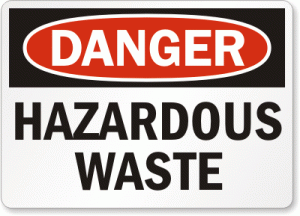The Devil is in the Details…Hazardous Waste Accumulation Areas

I have discussed identifying hazardous waste in What is Hazardous Waste? and determining hazardous waste generator status in The Devil is in the Details…What Type of Generator are You? Today we will tackle the issue accumulation time–the amount of time a hazardous waste generator is allowed to store hazardous waste on site. These requirements are based upon the company’s generator status. If you are uncertain about your company’s generator status please check out The Devil is in the Details What Type of Generator Are You?
The Resource Conservation and Recovery Act (RCRA) regulations identify two different types of storage areas for hazardous wastes.
- Satellite Accumulation Areas (SAA)—areas where hazardous waste is accumulated at or near the location it was generated in quantities less than 55 gallons.
- Main Accumulation Areas (MAA)—areas where larger quantities of hazardous waste are stored that has a time limit and other regulatory requirements.
Satellite accumulation areas are RCRA regulated in both large quantity generators (LQGs) and small quantity generators (SQGs). These areas have less stringent requirements than MAAs but must be located at or near the process that generates the hazardous waste. The quantity of waste at a SAA is limited to less than 55 gallons (or 1 gallon of acutely hazardous waste); however there is no time limitation. More than one type of waste may be stored at a SAA provided that the 55 gallon limit is not exceeded. In the event that the 55 gallon quantity limit is exceeded the hazardous waste containers in excess of the limit must be marked with the date and moved to the MAA within three days. Other important requirements for SAAs include the following: containers must be closed except when adding or removing waste; labeled with the words “hazardous waste” or other identifying verbiage; and compatible with the waste they store.
In a main accumulation areas the length of time waste is accumulated or stored is limited—for LQGs it is 90 days while SQGs have 180 days. This time begins for each container the day the hazardous waste is transferred to the MAA or the day waste is added to a container stored MAA. Compliance with this limitation is accomplished by dating the waste when it is initially transferred to the MAA or waste is added to a container in the MAA. Compliance can also be assured by scheduling waste pickups with an approved disposal company within the 90 or 180 day timeframe. For larger facilities, a number of waste tracking programs are available to assist with accumulation date compliance. Other requirements applicable to both SQG and LQG MAAs are weekly inspections, container labels, emergency procedures, waste analysis plans, preparedness and prevention plans as well and personnel training. Additionally all generators must meet Department of Transportation (DOT) requirements prior to hazardous waste shipment off site. LQGs also need to submit biennial reports every other year and have a contingency plan which must include detailed emergency procedures.
I must stress the importance of reviewing your state and local regulatory requirements as they may differ from the federal requirements on which this article is based. The next article in this series will focus on RCRA personnel training requirements.
Do you have questions about SAA or MAA management? Let’s talk about them, post your questions here.
